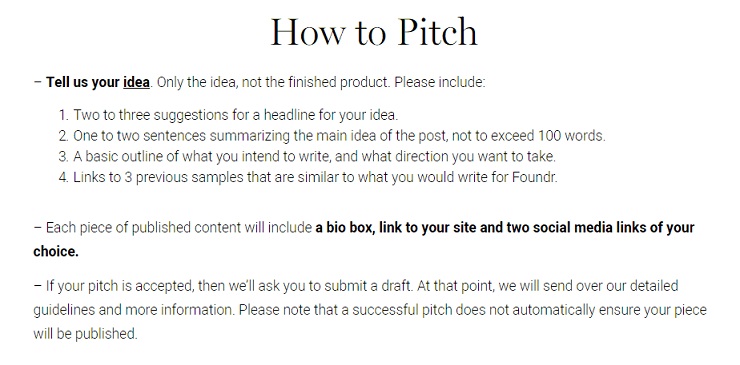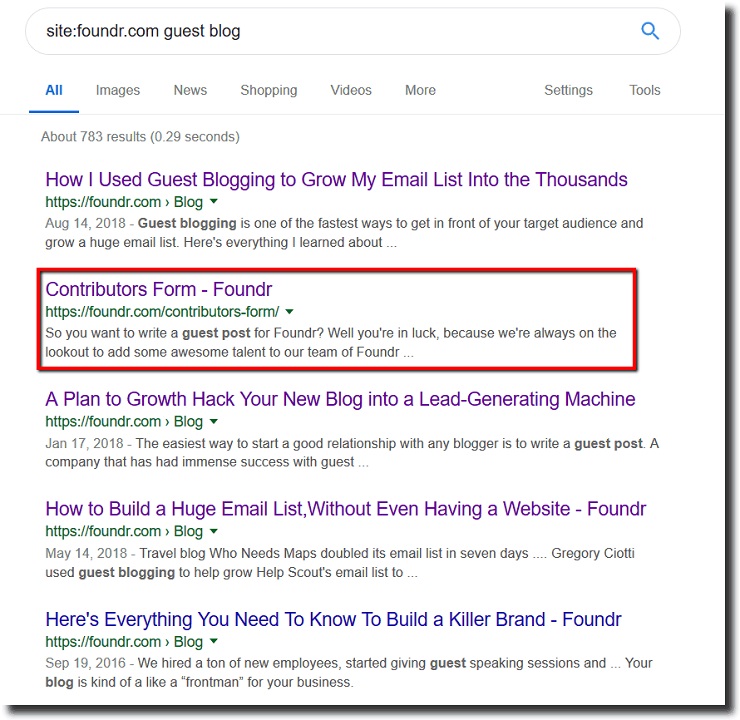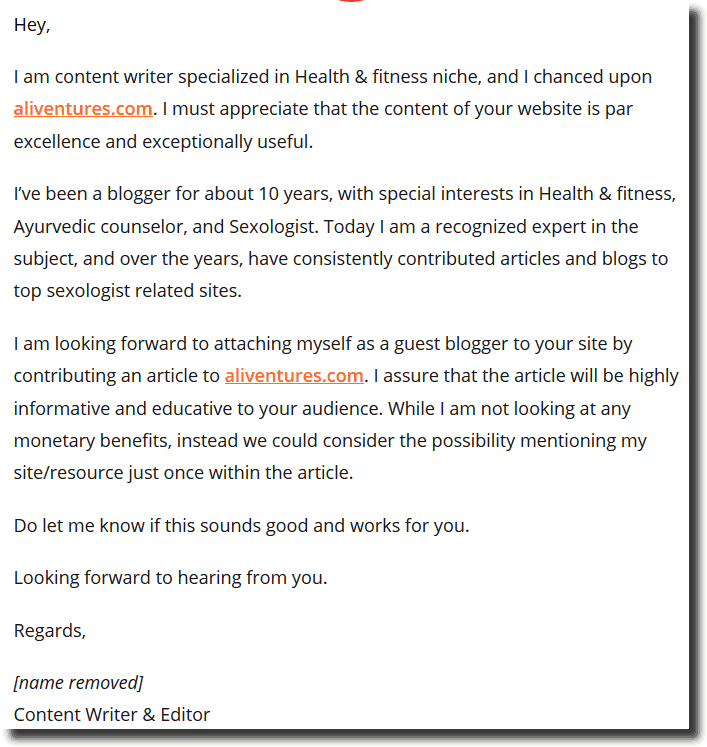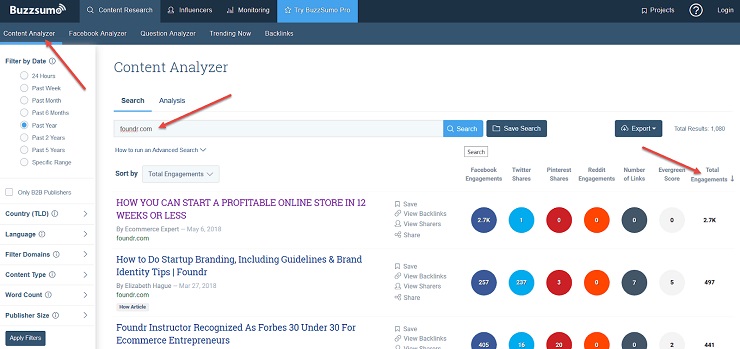I’m going to let you in on a little secret.
As the managing editor of the Foundr blog—the person who decides on what posts and authors we publish—I’m not really that tough to win over. My friends and family tell me I’m scary, but that’s just because I have a serious personality and a strong case of RBF. It’s a real thing, look it up.
Not all editors are like me. Some are tougher and some are, well, a lot tougher.
Here’s one thing you need to know, though:
Behind the scenes, most editors are not gunning to reject you. We are rooting for you and we want to help you get exposure and get published! If you want to submit a guest post to get some exposure for your business, all we ask is that you give us what we want in return, and that is a super-valuable piece that our readers will ADORE.
It’s far from an impossible feat, but it will require some work (and a little bit of heart).
Want to learn how to pitch a blog and get on an editor’s good side? Here are some tips on how to get noticed by myself and other blog editors.
And don’t miss out on my BONUS offer to review and critique your pitch!
Table of Contents
Don’t Kiss Up. Just Be Real.
Show Me Your Samples (Yikes!). How to Put Your Best Foot Forward
Follow Directions (All Of Them) In Your Blog Pitch
How to Win Me—And Other Editors—Over With Your Blog Pitch
How to Come Up With a Kickass Guest Post Topic
BONUS Blog Pitch Review: I’m Here to Help You Get Published
Don’t Kiss Up. Just Be Real.
Okay, so this one may not be a global editor dislike, but it irks me.
You don’t have to kiss up in your blog pitch to get published. Seriously, please don’t do this.
Let me tell you a story…
When I started my writing career, I was so desperate for work that I applied to jobs that were WAY above my experience level. I got on the phone with one potential client who berated me for what seemed like a lifetime. He ended the call by actually shouting at me, “You have no intelligence!”
Now if I was anything but a scared insecure writer, I may have told him off (I wish he would call me back now). Instead I fetal-position crawled into my husband’s lap like a child who just saw the boogeyman—and wept for a long time. (Please keep that between us :))
At this point, you either think I need a good dose of therapy (I strongly believe we all do), or you feel a little more at ease connecting with me because you realize I am human—just like you. Hopefully it is the latter.
Why did I tell you that story? Because you shouldn’t feel like you need to put on some phony facade of strength or perfection to get published. I value transparency and I want you to be real.
Look, we editors know that one of the main reasons you want to get published on our blogs is because you want exposure (and that’s OK). You don’t have to fake it. That’s a huge turnoff.
If you really super dee duper LOVE the Foundr blog, then that’s awesome! But, if you are not an avid reader (why aren’t you?) and you want some exposure, faking your undying adoration for our blog won’t do you any favors.
Having said that, I don’t recommend you lead in with a pitch like this…
Dear Jenna,
We both know that the only reason I am writing this blog post is because I want to get some exposure for my business. So, let’s cut right to the chase and get this thing going.
That email is going right into the virtual wastebasket.
What does a non-kissup intro look like? Essentially, anything that doesn’t come off as fake or forced. Here is an example:
Hi Jenna,
I stumbled upon your blog recently and liked what I saw. If you accept content from guest contributors, I’d love to be one of them!
I have some post ideas I have been working on and I thought one of them would be a great fit for your audience.
The pitch emails that have been most memorable for me were also somewhat personal and included what I call relationship-based communication. The writers took the time to research me online, where I am from, what I love, and mentioned a small personal detail or two in the email. This doesn’t mean I want you to stalk me :). But these small details show me that the contributors care, which also tells me that they will care about the contribution and give it their best shot.
The key is to be transparent, honest, and courteous. Just be real. I know you want some exposure, but I also want to know that you will put your best foot forward and give us a piece our readers will love. That’s what I care about most.
Show Me Your Samples (Yikes!). How to Put Your Best Foot Forward
High-profile blogs often request some writing samples before they decide to work with you. Even if they don‘t explicitly request samples, a good pitch should include a few links to your best work.
At Foundr, we request three sample writing links from contributors before we work with them.
We do this for a couple reasons:
- Our editorial standards and editing process are pretty strict. We always request edits, but we don’t always have the time to invest in hefty editing.
- I don’t like rejecting completed articles.
Let me rephrase that. I HATE rejecting articles. One more time…I HATE rejecting articles.
I’m not a mean ogre who wakes up every day just waiting for my next rejection so I can smash you like a little bug. In fact, rejecting fully written blog posts can keep me up at night. I really don’t like it.
Foundr is all about lifting people up, not shutting them down. It’s our mission to help entrepreneurs grow their businesses and I love being a part of that mission.
When I accept a pitch, but the contributor’s submitted piece gets rejected, it’s a sign that something went wrong in the process, either on my side or yours. If I can, I will do my best to resolve it, but it doesn’t always work out. Every now and then, I get a draft that will just never work for Foundr. The only way I can be as sure as possible that your contribution will pass muster is to review your samples beforehand. Relevant, authentic samples are our best insurance policy.
This is why I like to get samples beforehand. It’s also why we rarely take uninvited posts, before a pitch is accepted. If a writer’s samples are too far from our style, I will pass on the contributor. I don’t want to waste anyone’s time. And it pains me to have to reject a piece that you might have worked so hard writing. I would much rather you not write the piece in the first place, and I know many editors who feel the same way.
Having said that, I don’t mind working with contributors to teach them about our style and help them get published. As long as the draft is close enough that I can work with it without investing a huge amount of time into editing, we can collaborate on it.
I don’t care about your article on Forbes and Inc.
Sorry not sorry. You may have heard advice to link to your best pieces in your pitch email, to offer social proof. That is fine and something you should probably do.
But I’m going to let you in on a little secret: I don’t care that much about your high-profile media pieces.
The reason is that many of these outlets (which are great, btw) have highly skilled editors who can change up (or fix!) your content.
As a result, I usually shoot right past the high-profile outlet links and click to read the contributor’s blog, Medium, or LinkedIn articles—the unedited pieces. I don’t know if any other editors do this, so as a rule, keep sending your high-profile links. I’ll look at them too, but I may not be as impressed as other blog editors.
Here’s the thing: Just as important as your high-profile pieces are the samples that show your true self as a writer, your unique voice and story. It’s great if you have an awesome byline somewhere fancy, but it has to be paired with a clip or two that shows you have something unique to say.
I hope I haven’t scared you at this stage. Because the truth is that…
You don’t have to be a superstar writer OR entrepreneur to get published at Foundr.
I can’t speak for other publications, but here at Foundr, being an amazing writer is not a requirement to get published. That’s why we have editors. I will work with you on big picture edits to ensure your piece flows well. Also, our superstar copy editor Tate can make anyone sound like they just won a Pulitzer Prize (he’s that good).
You also don’t have to be a superstar entrepreneur. In fact, you don’t even have to be earning money. Many of our readers are early-stage and even aspiring entrepreneurs. Your stories and personal experiences (whether or not you’ve made it to the promised land) are extremely valuable to our community.
I LOVE collaborating with hard-working founders and aspiring entrepreneurs who are in the trenches daily who want to share their highs, lows, and golden lessons they have learned from their journeys. We are all about transparency and authenticity here at Foundr, and we value content that comes from a contributor’s real-world experiences, whether successes or failures.
So if you are an entrepreneur who has lots of gold to offer our audience that you have learned from your own experience—even if you aren’t a perfectly polished writer or filthy rich entrepreneur (yet)—please send us a pitch. We can help you share your experience. This is also the case with many other outlets who have editors ready to help you.
All that being said, you do have to submit a coherent, cohesive draft. One of my jobs as managing editor is to work with you to ensure your piece matches our style guidelines and is EPIC enough to get published. I just need some raw material to work with and we can make it happen.
Follow Directions (All Of Them) In Your Blog Pitch
If you don’t follow directions, it’s likely an editor will disregard your submission. Our time is valuable, as is yours, so when a submission is incomplete, it means you are not paying attention to detail.
To an editor who doesn’t know your intentions, this lack of attention to detail can make you look self-centered and unwilling to put in the most basic effort into producing a valuable post for our readers.
We want to help you, we really do. But you need to follow instructions. Please.
Each outlet will post specific instructions on what they would like to see in your pitch and/or final draft. Here are our instructions for Foundr blog pitches:
They aren’t that hard to understand, right? But here’s a sad statistic:
I estimate that 40-50% of the contributor requests I get do not follow these instructions.
They include a pitch but leave out the links. Or they include some links but no pitch ideas. Or I just get two quick sentences or a long bio and I have no idea what to do with it.
Here’s the hard reality: If you can’t take an editor’s instructions seriously, then we will have a hard time taking your pitch seriously.
Just follow directions; it’s that simple.
Also, read the blog that you are pitching a guest post to. If you are not familiar with the blog’s content, it will come across in your pitches. This sends a message that you are just copying/pasting and mass emailing people instead of submitting pitches that align with a blog’s content.
What if there are no instructions?
For some outlets, you may need to dig a little to find their guest blogging instructions. Here’s one quick way to do it:
Perform a “site:” Google search using the site name plus another phrase like “guest blog.” Use the operator site: as it tells Google to search for your keyword using only the site you add after the operator.
Here’s what it would look like if I wanted to search Foundr’s site for terms related to “guest blog.”
Some other phrases you can use to search are:
Guest post
Guest posting instructions
Guest blogging
Guest contributor
Contributor instructions
Become a contributor
Submit blog
Can’t find any instructions? Read and follow the advice in the next section on how to send a winning blog pitch.
How to Win Me—And Other Editors—Over With Your Blog Pitch
So here’s another little secret (I’m dishing all the dirt today!). It doesn’t take a lot to win me over.
When I was dating my husband, my favorite moments were playing video games on his couch with a comfy blanket. I’m a cheap date.
But one thing I can tell you is that, whether or not the blog owner is as easy to impress as I am, we are all looking for the same thing—a concise message that tells us exactly how you can wow our readers with your submission.
Want to learn how to cold pitch an editor? When it comes to winning blog pitches, here’s what works for me, and what I find works for other blog editors/owners.
The Subject Line
The subject line may be important to other editors, but I actually don’t read into it that much. I open every email, so if you send something coherent (and nice) I will likely open it.
Other editors may not get to all of their emails, however, so a compelling subject line can stack the odds in your favor.
Some tips:
- Don’t be pompous. A subject line like, “Your next superstar blog contributor is here” may get opened—for entertainment—and then quickly discarded.
- Keep it short and concise.
- Use the editor’s name. Example: “Jenna, can we talk?” Headlines like these also arouse curiosity. It’s a bit of a gamble, and may not work for every outlet, but might just get you that second look.
The Body
For the body of your message, never use a template. The goal is to show the editor that you did your homework and you understand the blog’s style and audience. You don’t have to even tell editors that you did this research. They will know right away from your pitch email.
Here’s a great blog pitch example I received from Dean Yeong over at Sumo. (He gave me permission to post it)
Here’s some reasons why I liked it:
- The subject line was short and concise and it told me that he is looking for a collaboration, not just some quick exposure
- The email was quick and to the point. It didn’t meander or kiss up.
- He showed me that he understands what we write about on our blog by mentioning “digital marketing, startup, and entrepreneurship.” With that same sentence, he also showed me that he has experience writing about these topics.
- His pitches aren’t typical. They are unique and not something I would find everywhere on the web. He clearly took some time to craft them.
Here’s some other ways to nail your pitches:
- Go the extra mile – Not by sucking up, but showing editors you did your homework and you know the type of content our readers love. See the next section on how to do this research.
- Read (and UNDERSTAND) the guidelines before you pitch. If you pitch to me “5 ways to market your startup in 2019.” I will automatically know you didn’t read our guidelines or review our blog content.
- Let us know why you are pitching your topics. If you have personal experience, I’d love to hear about it because this tells me you will have something unique to offer. Just don’t meander on about your entire backstory. Keep it concise.
- Offer at least three topic pitches. This way, you have a better chance of connecting with the blog editor on a potential topic. Brownie points if you can offer five topic suggestions, but they all need to be great and applicable to the blog’s readers; that is most important (quality over quantity).
- If your blog topic is somewhat ambiguous or you feel you need to explain your topics to really sell them, feel free to do so. Just keep it concise and tell us how the piece will benefit our readers, or even change their lives. This is what we are looking for.
- Don’t send a template pitch. If you tell me that you appreciate my content and you find it “exceptionally useful,” I may not read further. I’ve seen all of the templates and I can spot one a mile away. So have other blog editors.
I took this example below from this Problogger article. Similar to the author of this article, I also thought it was a good example of what NOT to do.
This is a template letter, which makes the writer seem disingenuous. The proposed topics were also not related to the blog and the mention of a link sends red flags to most editors.
I will say it again here, Just Be Real.
How to Come Up With a Kickass Guest Post Topic
Your pitch may be top-notch, but if your proposed blog topics are off base, you probably won’t get a reply.
If your blog topics are way off, I won’t respond. But, if your pitches are somewhere in the ballpark, I don’t mind working with you to brainstorm some good topics. As long as you are flexible enough to tweak your pitch so that it aligns with our audience, we are good to go. Not all editors will be able to take this time though, so always go in with your best foot forward.
How to Research a Topic the Blog’s Audience Will Love
To come up with a good topic, first you need to know what resonates with the blog’s readers. Here are some tips on how to figure that out:
Shares and Comments
What articles get shared the most on the blog? Which ones have the most comments? These are the ones that resonate most with our readers.
Research the blog’s popular articles using Buzzsumo. You don’t even need a Pro account. Using the Content Analyzer, search the blog’s domain and review the total engagements for each article.
Blog categories
What categories does the blog publish? Categories can give you a top-level understanding of what topics the blog puts out.
Products and Lead Offers
What products does the blog sell? What lead offers do they give away? These topics will be the most important, since businesses will only invest in products and lead offers that resonate with their audiences.
Quick Tip
Sometimes your pitches will be good for our audience, but we will have already written about them, ad nauseam. I recommend you search your topic on the blog before you pitch so you don’t submit a duplicate.
Having said that, since I am often working on 25-30 topics with writers and contributors that are still going through the editorial process, you would have no way of knowing if you are duplicating those, since they aren’t published yet.
So in addition to your pitches, mention some topics or niches where you have expertise. This way, the editor knows which topics you are comfortable writing about and they can work with you on another pitch if you submit some duplicates. This is also another way to recapture the editor’s attention if your pitches are noteworthy but not 100% spot on.
Saying something like this in your email will work well…
If you are interested in another angle or topic, I have expertise in X, Y and Z and enjoy writing about these topics.
Note that if a topic has been covered on a blog, you may be able to find another angle. As long as the piece will be unique from the one already published, you should be okay.
UNIQUE Topics Will Get Our Attention
More than anything else, blog editors are looking for topics/angles that haven’t already been plastered all over the web.
If you have an article you are trying to unload somewhere and you email us to slyly try to retrofit it to our blogs, we know what you are doing.
I actually got a pitch once from a pillow manufacturer wanting to submit a blog on how entrepreneurs can get a good night sleep on the right pillow. You just can’t make this stuff up.
What does a unique topic look like?
Well, first, here are some examples of boring topics you can find anywhere with a simple Google search:
5 Ways to Market your Company in 2019 (Yawn)
How to Become a Better Blogger (Snore)
We aren’t looking for a Wikipedia article. Don’t send something like this to blog editors, especially those who run high-profile blogs. Great blog topics are focused, have unique angles and grab readers’ attentions.
Here’s some recent blog headlines from Foundr:
Broke, Inexperienced, and Working a Full-Time Job? You Can Still Become an Entrepreneur
How to Become a Digital Nomad and Run a Successful Business While Traveling the World
Can you see the difference? These topics are more focused, more interesting, and they evoke an emotion from readers. They have an angle, hook, or even a personal story to hinge it on.
BONUS Blog Pitch Review: I’m Here to Help You Get Published
One last thing before I conclude…
If you are one of those people (like I was) who is afraid to submit to blog editors for fear of rejection, please don’t let that stop you. You will get rejected at some point; it’s inevitable. It happens to the best of us.
As a professional writer, and someone who sends in blog pitches to get myself and my clients published on other outlets, I know what it’s like to be on your side and face tough editor rejection. It can hurt like hell.
Not only that, it can be frustrating, because every rejection becomes another roadblock in your eternal quest for greater exposure.
Just know that most blog editors want to help. As long as you genuinely want to provide an awesome piece for their audience, it will come across in your pitch. Plus, if you follow what I am teaching you here, trust me, your pitch will be better than half of what makes it to my inbox.
So before you send off that blog pitch email…
- Did you read through the blog and review the top shared posts to get a feel for the type of content it publishes?
- Did you read through all of the guest posting guidelines? Have you followed ALL of the instructions?
- Are your topics unique and different from what’s already on the web?
- Are you genuinely wanting to provide an awesome piece for the editor’s readers?
- Take off your brown-nosing hat and be real
- Keep your pitch email concise
- Go for it!
Bonus Pitch Review
Want some feedback on your pitches? Comment below with a part of a pitch you are working on and I’ll give the first 10 pitches feedback on how to make your pitch stronger. Please keep your comments to a few sentences, just enough for me to see the direction you are going. And if it’s truly amazing, I might even ask you to email a full pitch to me for the blog!
Before you pitch, make sure to read this entire blog so you can apply what you learned to your sample pitches.
Do you have any other questions about our contribution process? I would love to help. Hit me up in the comments!























